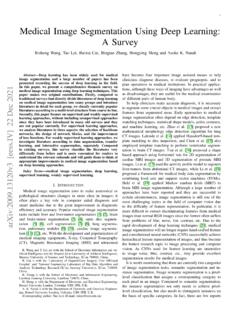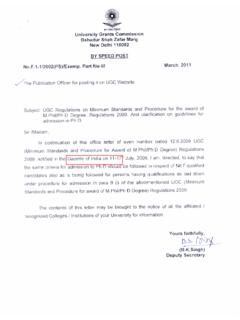Transcription of Quantum Confinement - Brunel University London
1 1 Quantum DOTS Quantum Confinement Gopal Ramalingam1, Poopathy Kathirgamanathan 2, Ganesan Ravi3, Thangavel Elangovan4, Bojarajan Arjun kumar 5, Nadarajah Manivannan6, Kasinathan Kaviyarasu7 1,5 Deapartment of Nanoscience and Technology, Alagappa University , karaikudi- 630003, Tamil Nadu. email: 2 Department of Chemical and Materials Engineering, Brunel University London , Uxbridge, UB8PH, UK 3 Deapartment of Physics, Alagappa University , karaikudi-630 003, Tamil Nadu 4 Department of Energy Science, Periyar University , Salem -636 011, Tamil Nadu, India 6 Design, Brunel University London , Uxbridge UB8 3PH, UK. 7 UNESCO-UNISA Africa Chair in Nanoscience's/Nanotechnology Laboratories, College of Graduate Studies, University of South Africa (UNISA), Muckleneuk Ridge, P O Box 392, Pretoria, South Africa.
2 7 Nanosciences African network (NANOAFNET), Materials Research Group (MRG), iThemba LABS-National Research Foundation (NRF), 1 Old Faure Road, 7129, P O Box722, Somerset West, Western Cape Province, South Africa Abstract Quantum Confinement is the spatial Confinement of electron-hole pairs (excitons) in one or more dimensions within a material and also electronic energy levels are discrete. It is due to the Confinement of the electronic wave function to the physical dimensions of the particles. Furthermore this can be divided in to three ways: 1D Confinement (free carrier in a plane) - Quantum Wells, 2D Confinement (carriers are free to move down) - Quantum Wire and 3D- Confinement (carriers are confined in all directions) are discussed in details.
3 In addition the formation mechanism of exciton, Quantum Confinement behaviour of strong, moderate and week Confinement have been discussed below. Keywords: Quantum dots; Energy level; Exciton; Confinement ; Bohr radius; 1. Introduction of Quantum Confinement The term Quantum Confinement is mainly deals with energy of confined electrons (electrons or electron-hole). The energy levels of electrons will not remain continuous as in the case of bulk materials compare to the nanocrystal. Moreover, obtains the confined electron wave functions, they become a discrete set of energy levels as shown in the figure 1. Such kinds of effects appear when the dimensions of the potential approach nearly to de Broglie wavelength of electrons and resulting in the changes or discreteing levels of energy.
4 The effects are defined as Quantum Confinement and consequently, for nano-crystals are often called Quantum dots (QDs). Furthermore, this Quantum dot effect influence into the nanomaterial properties such as electrical, optical as well as mechanical behavior of material . It is due to the peculiar nature in nano material possess higher energy electrons than the bulk material s. Depending on the QDs size, confined electrons have higher energy than the electrons in bulk materials. 2 The semiconductor nanomaterials exhibit fascinating properties when reducing their dimensionality from 2D to 1D or 1D to 0D. Perhaps, the Quantum Confinement effect occurs when reducing the size and shape of nanomaterials is less than 100-10nm or even lesser.
5 These changes due to discrete set of elelctron energy level and that lead to size Confinement [1-3] figure 1&2. To know more about Quantum Confinement it is necessary to understand the phenomenon of Quantum dots (QDs). QDs are the new class of materials in which Quantum Confinement effects can be evident. QDs are very tiny semiconductor crystals in the order of nanometer size and also molecules are tightly confined electrons or electron-hole pairs called excitons (explained in the next section) in all three dimensions. QDs are a subatomic group in the family of nanomaterials, which comprises metals, insulators, semiconductors, and organic materials.
6 It s well known, the Quantum Confinement occurs only in semiconductors Quantum dots and because of their tunable bandgap nature than zero band gap in metals respectively. As mentioned before the peculiar tunable band gap properties QD are composed only group such as II-VI, III-V, and IV-VI based materials. The optical, electrical and bandgap are tunable with respect to changes in particle size that leads to different multiple application. The main discussion is that, how bandgap can be tuned with respect to size? For that we need to understand the formation of discrete energy levels and the formation of excitons. 2. Formation of discrete energy level To understand or recall the formation of discrete energy level, when atoms are brought together in a bulk material the number of energy states increases substantially to form nearly continuous bands of states.
7 And also decreasing trend was occurred in the amount of atoms in material and energy states were delocalized with Confinement nature. Furthermore, electron-hole pairs converting spatially confined nature when the particle towards natural de-Broglie wavelength of electrons in the conduction band. As a result the energy difference between energy bands is increased with decreasing in particle size dimension as shown in the figure 3. Particle behaves like a free particle when the dimensions of the confining structure are very large in comparison to the de Broglie wavelength. On this stage, the energy states are continuous and the bandgap is comes to its original position and another energy spectrum does not remain continuous and becomes discrete in nature when the dimensions of confining structure are decreased towards nanoscale.
8 Therefore, the bandgap exhibits size dependence properties, and eventually causes a blue shift in the emitted light as the particle s size is decreased. However, this effect demonstrates the consequences of confining the electrons and electron-hole pair (or the excitons) within a dimension which approaches the critical Quantum limit, often termed as the Bohr exciton radius. In this view, a Quantum dot confines in all the three dimensions; a Quantum wire (nanowire) confines in two dimensions; and a Quantum well confines only in one dimension. The corresponding structures are also termed as zero dimensional (0D), one dimensional (1D), and two dimensional (2D) potential wells, respectively, with regard to the number of dimensions in which the confined particle has freedom of movement.
9 The below figure 4 shows the overview of Quantum Confinement in nanostructures. 3 Electrons confined in one direction: Quantum Wells (thin films): Electron scan easily move in 2 dimensions (2D) so, one dimensional is quantized. Electrons confined in two directions: Quantum Wires: Electrons can easily move in 1 dimension (1D) so, two dimensional is quantized. Electrons confined in three directions: Dots:electrons can easily move in zero dimensions(0D), hence three dimensional is quantized. In conclusion, each Confinement direction changes a continuous k component to a discrete component characterized by a Quantum number n. 3. Formation of Excitons It is very important and necessary to understand the concept of excitons as it is the primary steps to understand QDs and as well as Quantum Confinement in semiconductors.
10 In the case of semiconductor, electron where shifted from valence band to conduction band when emitting light falling on it and consequently recombination effect impose or create the photon particle. The electron and hole were occupied or created from conduction band and valance band respectively. However, charge of hole is equivalent to the electron charge which is helping to implementation of one particle named as excitation. Above mentioned charges and Coulomb exchange interaction there is an attractive connection between the electron and the hole. Such kind of electron-hole pair is some time expressed in simple term quasiparticle which is named exciton.
















